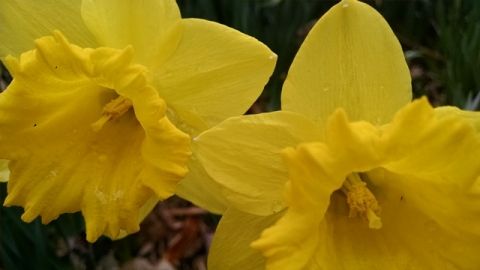
Not all narcissus are daffodils, but all daffodils are narcissus. We are all familiar with this flower in its many forms. It is one of the most popular flowers in Catskills gardens at this time of year. Narcissus is a genus, a grouping of closely related species, and daffodils are a group of varieties derived from some of those species.
One characteristic that all narcissus have in common is that the inner ring of petals surrounding the flower sex parts is fused to form one structure, the corona. In the narcissus pictured in photos 1 and 2 below, the corona is yellow, while the outer petals are white. The most primitive narcissus have short, cup-shaped coronas, photos 2 and 3 below, but other narcissus have evolved bell-shaped or tube-shaped coronas, photos 1 and 4.
The genus as a whole is centered in Spain and Portugal, with many species originating there. While many plants have come to European gardens from Asia, the narcissus is one that has actually traveled eastward, reaching China by 1000 AD. The poet's narcissus (also called pheasant's eye narcissus) was the first to be widely cultivated in European gardens. It has a short cupped corona at the end of a long narrow flower tube. This type of flower shape and the intense fragrance indicate that the pheasant's eye evolved to be pollinated by large, long-tongued moths. The flower tube is narrow, which excludes bees. When the moth extends its tongue to sip the nectar at the base of the flower tube, it gets pollen all over its face, which will fertilize the next flower the moth visits. Photo 3 below shows this flower shape; the gray arrow points to the long tube behind the white petals.
The trumpet daffodil, however, shows a different flower shape, where the corona is a long trumpet shape, hence the common name. In fact what makes it a daffodil in particular is the fact that the trumpet is as long as the outer ring of petals, rather than shorter, as in other narcissus. The daffodil flower shape evolved to attract primarily long-tongued bees like the bumblebee as pollinators. The flower tube is wide enough for the whole bee to enter. The female part of the flower, the stigma, sticks out of the corona while the male parts, the stamens, are deeper within the flower tube. This forces the bumblebee to brush up against the stigma on its way in, depositing pollen from another flower as it pushes its way down to collect the pollen of the flower it is visiting at the moment. In photo 4 below of a daffodil flower structure close-up, the up-pointed arrow shows the stigma and the left pointing arrow points to the stamens, which are shorter than the stigma.
Visit From Root to Shoot's website to see more pictures of daffodils and narcissus in the Narcissus Gallery, and to find out more about From Root to Shoot!



